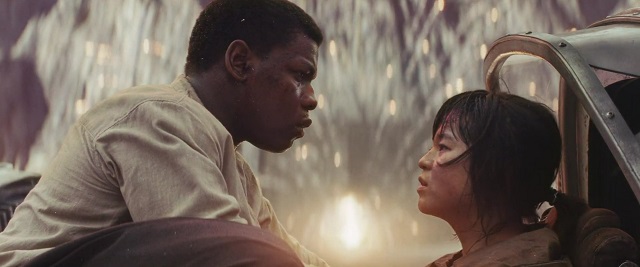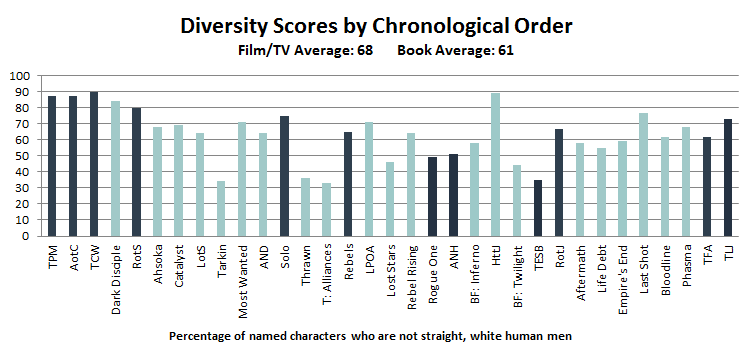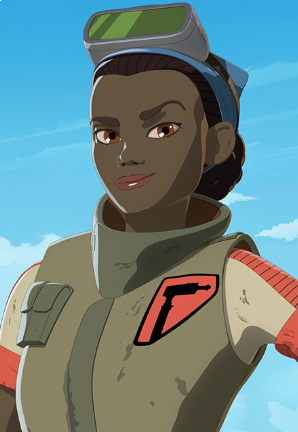
As you may know, a little personal project of mine is to tabulate and track the demographics of named Star Wars characters from year to year, so that we fans can discuss with some accuracy how diverse they are (or aren’t). If this is the first you’re hearing of it, click the series tag at the end of the piece or see last year’s entry for a more thorough explanation. It’s been an interesting year for this subject—two new films have been released since my last update, and only three original adult novels. [1]One of which, Most Wanted, is technically “young adult” but for my purposes I’ve found that distinction to mean basically nothing. This is a self-explanatory phenomenon, of course, because two films means two novelizations, which means two fewer original stories. Add in the final season of Star Wars Rebels and for the first time, the amount of visual Star Wars media in a given year equaled the amount of published media—at least by the methods I’ve chosen for this project.
While that’s very much out of the ordinary for the franchise—last year’s update included one film, one season of Rebels, and eight novels [2]Ahsoka, Catalyst, Empire’s End, Thrawn, Rebel Rising, Inferno Squad, Leia: Princess of Alderaan, and Phasma.—it helped bring into focus something I’ve only vaguely acknowledged over these last few years: when characterizing the overall diversity of the franchise no amount of novels can really compare to the representational value of a movie star. So even though there are far more novels overall than films or television series, the latter category deserves at least equal weight to the former, debatably even moreso—and with multiple live-action television series on the way it’s only getting more important.
Another development of the past year was the dawn of the #SWRepMatters social media campaign. Short for “Star Wars Representation Matters”, the hashtag was started by a group of fans on Twitter that includes several former Eleven-ThirtyEight guest contributors to highlight different communities of underrepresented people and why they belong both in the Star Wars universe and behind the camera (or pen). It’s been a great campaign to watch (with no signs of letting up!) in part because of the diversity of participants—one reason I choose to talk about this in such a dry, academic way is because I’m not from an underrepresented community; I can’t speak about it as insightfully and passionately as fans who really do long for that representation, and I wouldn’t presume to be an arbiter of which characters are or are not “good representation”—numbers, though, I can do.

In terms of general character diversity, The Last Jedi (73) and Solo (75) do pretty well but not exemplary—well above the original trilogy’s average score of 51 but not quite reaching the hugely diverse prequels’ average of 85. They’re a marked improvement over The Force Awakens and Rogue One, though, so if you’re inclined to believe there’s a proactive desire on their part to do better at this there’s evidence to support that—not to mention that all four modern films are crushing the original six if you focus specifically on the lead characters. Meanwhile, the three new novels were a mixed bag: Last Shot and Most Wanted scored in the seventies while Thrawn: Alliances was, well, about the same as the first Thrawn. I’m happy to report that Zahn’s improvement in the area of female Imperials continued apace from that first book, however. [3]I never scored the original Thrawn trilogy on gender parity but it’d be an interesting experiment now that Zahn has a third canon book on the way.
Speaking of which, I can say that whatever their overall demographics, this year’s two film releases had a heaping helping of fascinating, provocative female characters. While critiques certainly exist of how TLJ uses Admiral Holdo, and how its women and characters of color intersect generally, many were quick to label it a “ferociously“, “triumphantly“, feminist movie—at least by Star Wars standards. I point that out not to endorse it as the only valid reaction but as a contrast with Solo: A Star Wars Story, whose female characters met with some much more universal pushback. While Qi’ra acquitted herself fairly well—thanks in large part to her managing not to die—Val and L3-37 had no such luck, falling by the wayside and even being used for parts in order to advance the male characters’ arcs. By the final act’s reveal that Enfys Nest was herself a solemn, formidable woman of color, many fans had already run out of patience.
So what if I told you that Solo actually came closer to gender parity than TLJ?

With eight named female characters out of twenty-four total, Solo scores a 33 to TLJ’s 30 (eleven out of thirty-seven). I should note here that both scores are pretty good by historical standards—at the dawn of the new canon, when all I had to go by was the first six films and The Clone Wars, the average parity score was 21. Sadly, the years since have only managed to nudge that up to 22—it will take a lot to mitigate the terrible gender demographics of the original trilogy (and, frankly, Rogue One) but if the past year is representative of a new normal among Star Wars visual media it’s a respectable start.
But still: Solo scored higher than TLJ? Really? While that’s due in large part to Solo having an unusually small named cast, it was still a hard pill to swallow, and if I’m honest, it cast a harsh light on this entire operation of mine—obviously the actual quality of the characters as written is at least as important as how many there are, but if the two factors can diverge that much, of what real value is this information? If gender parity or overall diversity tick up or down a couple percentage points from year to year, is that actually important to know when compared to quality of representation?
Diversity vs. Representation
Patting myself on the back is fun and everything but I wanted to ask around on this one—diversity of opinion counts for something too, so I reached out to a few others to see how they felt. ETE’s own Jay Shah was uncertain. “On one hand, I like the idea of quality over quantity. We’ve got some good, solid representation [which is] possibly more important than a numerical value. But I think it’s still a problem if we haven’t pushed the needle on representation, not because I care about any specific number but because the whole idea was to make our fiction resemble the diversity of the world we live in.” Indeed, the needle hasn’t made much progress—the average diversity score back when I was doing this for the Expanded Universe was about 67; as of this year, the canon novels are averaging a 61. Parity scores have gone up a respectable six points since the new canon began, but the current 27 still amounts to almost three out of four characters being male. Jay conceded that he’s “not super concerned with numbers when we’ve got quality characters (especially characters who are leading their projects, like Cassian, Iden, Rey, etc.) but it still matters if there’s a stark difference from real life.”
I also asked the vocal participant in #SWRepMatters (and Rae Sloane fangirl) known on Twitter as @southerncynic, who said that “treatment of POC characters on screen is still an overall issue. We’ve proven that female leads can break the box office. Black Panther has proven that a film with mostly black actors can break the box office, so…why can’t we have either of these things in Star Wars? It’s as if they are testing the waters”, she observed, “slowly adding more POC faces. First step, Boyega. Second, Kelly. Third, Thandie? I am happy that in the background there are more people who look like me being shown, but I am not satisfied.” The expression “testing the waters” definitely struck a chord with my experience—after almost a decade of this, even if you only look at the best, most progressive works, it tends to be a little improvement here, a little there, much of which is buried by the drumbeat of other works that don’t advance representation at all.

Finally, Swara Salih, one of the originators of #SWRepMatters, raised another matter altogether. “We need directors and writers of color, especially women of color to work on these films. There’s so much that goes into the creative process and the creator brings their personal and individual experience with them to writing these characters of color.” The data, for all its limitations, bears this out—if you separate the twenty-one canon novels by author gender, the nine female-written books score nine points higher than the twelve male-written books on both diversity and parity: 66-57 and 32-23, respectively. Alas, such a comparison is impossible among film directors because a woman hasn’t had that opportunity yet. While less concerned with hard numbers than I am, Swara noted that “it’s honestly just better overall for storytelling to have diverse perspectives. Besides avoiding problematic optics, the experiences of people of marginalized backgrounds can be enriching for your universe.”
More of this, please
While I was bothering them, I also asked my intrepid interviewees to tell me about some specific new characters they saw as exemplary representation. While it’s too soon to begin scoring it, the phenomenally diverse Star Wars Resistance had a huge presence in their responses, further reinforcing my sense of visual media’s increasing role in this conversation. That said, any recap of the past year in representation has to begin with Rose Tico, our first-ever leading woman of color.
“Rose’s earnestness,” Jay said, “both in her initial awkward encounter with Finn (let’s be honest, we’d all sound like her) and her insistence on heroes living up to their reputation and fighting for the right reasons makes her feel more like a regular person to me than a movie character.” He felt the same way about Resistance‘s Kazuda Xiono: “Both Rose and Kaz feel more like regular people than many SW characters, and that’s what representation is. They’re just…normal people, that look like Asians in space.”
 Swara also brought up Kaz, whom he called “an absolute delight of a character. He’s optimistic, relatable, and even though he messes up, always tries his best. He’s just a fully fleshed out lead character, who leads a cast of amazing diverse characters of color like Yeager, Tam, and Torra. The great thing about Resistance is that we get to see almost all of them with so much joy. That’s uplifting and important for kids and adults to see.”
Swara also brought up Kaz, whom he called “an absolute delight of a character. He’s optimistic, relatable, and even though he messes up, always tries his best. He’s just a fully fleshed out lead character, who leads a cast of amazing diverse characters of color like Yeager, Tam, and Torra. The great thing about Resistance is that we get to see almost all of them with so much joy. That’s uplifting and important for kids and adults to see.”
“While they gave each a small episode to tell us a bit of their background, I’d like to see and learn more about” Yeager and Tam, @southerncynic added. “Especially Tam, being a black female mechanic and the best amongst a bunch of cut ups. She has big dreams and goals and she’s just stuck there fixing ships. It would be interesting to see a time jump and where she lands in the future.”
While it’s likely that a year from now I’ll be pointing to Resistance as a new diversity high-water mark (though The Clone Wars was no slouch in its day), such visceral reactions to these characters can’t be underestimated—not only is the show chock-full of characters of color (not to mention all sorts of fun alien species we don’t often get to know), but only a dozen or so episodes in, fans young and old are really responding to them on a personal level. Diversity isn’t just a superficial concern; it’s about giving fans characters to identify with, and the more the better.
I’ve observed before that only having a single character from an underrepresented population can create unfair burdens on that character—Padmé is the only major female character in the prequels, so when she dies of a broken heart, for example, it’s easy to read that as not just an iffy character choice but a comment on women as a whole, because there are no countervailing examples. This could have contributed to some of the controversy surrounding Rose in TLJ as well (not to mention Finn and Poe), so it’s heartening that Episode IX has cast Naomi Ackie in what’s rumored to be a significant role. Resistance, of course, already has two significant women of color in Tam and Torra—two characters who couldn’t be more different from each other, because why wouldn’t they be?
This is where I see my data as intersecting with the issue of “good representation”—a character that means the world to one fan might be a tiresome cliché to another, so what’s a better strategy on the creators’ part: not trying at all, or giving us as many options as possible?
Odds and ends
Since I can only keep up with so much of this franchise’s output, I have to make some tough calls about which content, quite literally, “doesn’t count”. [4]For more on what I consider to be “one Star Wars Unit”, see last year’s piece. These decisions are of course entirely subjective, so I try to at least be conscious of what’s going on outside the films, television, and adult novels in case something really warrants bringing up. Last year, for example, I was thrilled to share two years’ worth of Star Wars comic book data courtesy of Mynock Manor‘s Ryan Malin. Ryan and I have remained in touch since then and we’re keeping a particular eye on the disparity between female and male comics writers, both in real-world numbers and in terms of those writers’ scores—he’s finishing up with 2018’s data as we speak so keep your eyes peeled and we may have more on that soon.

There’s also been some noteworthy shorter content over the past year—while short stories like those included in From a Certain Point of View and Canto Bight typically have much smaller casts than a film or a full-length novel it’s nevertheless encouraging to see them do well, at least anecdotally. Canto Bight in particular has no WHM leads at all and possibly only a couple altogether—not hugely surprising given its demographics in TLJ, but still cool. While I stand by my decision not to present shorter works on equal footing with novels, I’m considering separately scoring the Canto Bight novellas next year alongside at least some of the middle-grade books, which likewise have been quite impressive—last year Guardians of the Whills managed a diversity score of 100 and I suspect this year’s Lando’s Luck might not be far behind.
Speaking of next year: not only will 2019 mark the fifth full year of the new canon and the conclusion of the sequel trilogy, it will also mark ten years since I first started doing this whole “diversity score” thing. Over the last decade the conversation around diversity and representation has expanded and evolved in ways that absolutely stagger me, egged on unsurprisingly by Star Wars’ sudden return to box-office and cultural dominance. I’ve learned a great deal from this process, not just about the content but about what really matters to underrepresented fans and how to talk about it in ways that are inclusive and foster further discussion and understanding. While I hope I’ve contributed to that understanding in a positive way, I’ve also come to appreciate all the things this data can’t tell us, and with that said, next year will be my final Minority Report.
On top of presenting my final scores for the sequel trilogy, plus the first season of Resistance and another year’s worth of novels, the five-year anniversary of the new canon seems like a good opportunity to look back at just how much the needles have or have not moved so far—so for the first time I’m also going to conduct a chronological, year-by-year analysis of not just individual works’ scores, but the franchise as a whole. The Mandalorian may or may not make it into my final report but it goes without saying that live-action television is going to substantially impact the numbers going forward and I’m excited to see what that looks like.
Beyond next year I do plan to continue running the numbers like I’ve always done, but rather than presenting them by rote on a regular schedule—something I generally prefer Eleven-ThirtyEight not do—I’ll save my observations for when and if something especially noteworthy happens. Here’s hoping Rian Johnson’s new trilogy finally gives us the all-porg cast we deserve.
| ↑1 | One of which, Most Wanted, is technically “young adult” but for my purposes I’ve found that distinction to mean basically nothing. |
|---|---|
| ↑2 | Ahsoka, Catalyst, Empire’s End, Thrawn, Rebel Rising, Inferno Squad, Leia: Princess of Alderaan, and Phasma. |
| ↑3 | I never scored the original Thrawn trilogy on gender parity but it’d be an interesting experiment now that Zahn has a third canon book on the way. |
| ↑4 | For more on what I consider to be “one Star Wars Unit”, see last year’s piece. |
